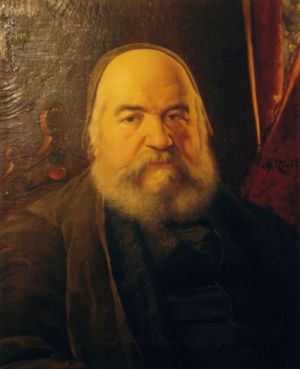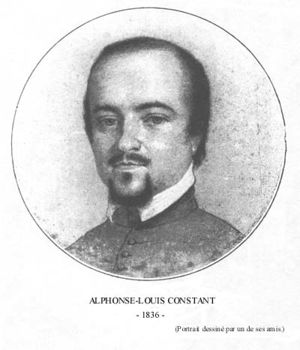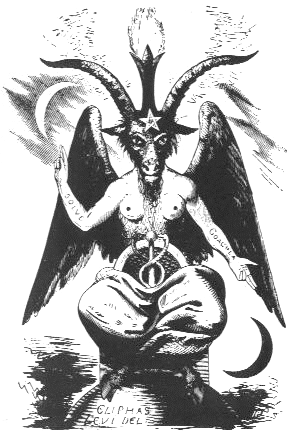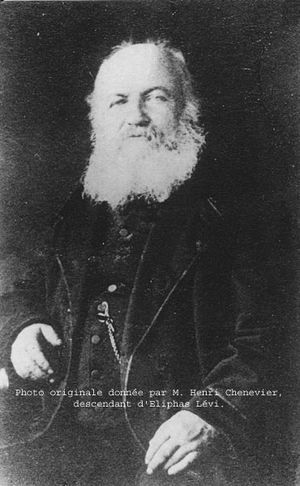Éliphas Lévi
Éliphas Lévi, also Éliphas Lévi Zahed was the pseudonym under which from 1854 on the catholic cleric Alphonse-Louis Constant (February 8, 1810, Paris - May 31, 1875, ibid.) wrote and published scriptures of occult and magical contents. Lévi is said to have been the re-founder of occultism in the 19th century.[1]
Life
Per aspera ...
Alphonse-Louis's father was a shoemaker living in what is today the 6th Arrondissement in Paris, on the left bank of the Seine. The family's material conditions were very limited, but the parson at the church of Saint-André-des-Arts was running a school free of charge for the poor, at which Alphonse-Louis too would receive basic education. After that, and several intermediary steps later, last of which the seminary of Saint-Sulpice, in 1835 he became ordained sub-deacon, and from then on he was himself entrusted with teaching appointments. With one of his schoolgirls (whom in his confusion he took for a reincarnation of Virgin Mary) he fell in immortal love, and left the seminary for her just before he was to be ordained priest. But alas, she ran out on him.
Overcome with disappointment when he quit his education, his mother took her life a few weeks later. For Alphonse there commenced a time of aimless searching. Within just one year he made the acquaintance of Honoré de Balzac, developed his gifts of visual arts by collaborating on the chorus line "Les Belles Femmes de Paris", made friends with the militant socialist Flora Tristan, and yet at the same time he carried on dreaming of a future as a priest. This dream guided his way to St. Peter's Abbey, a Benedictine monastery whose library of 20,000 volumes gave him the chance of making himself acquainted with scriptures from the early Christianity, by ancient gnostics, and by religious mystics as well. It was here that he authored a first booklet of his own entitled "Le Rosier de Mai" which was as pious as romantic, and rhapsodized about matters of love in so romantic and vivid a way that it was deemed better to expell him from the monastery.
Following an intervention in his support by the archbishop of Paris, Denis Auguste Affre, Constant finally was given an appointment as warden at the college of Juilly, east of Paris. However, his seniors treated him badly, but now all the wrath broke out of him, and he wrote a first raging pamphlet, La Bible de la liberté. With its publication in February 1841 he not only provided for a outright scandal throughout the ecclesiastical hierarchy, but at the court in Versailles as well[2]. He was arrested, and sentenced in May 1841 to eight months of imprisonment, with an additional fine of 300 Francs. Since he couldn't afford the money he served eleven months, a time which he used for studying the works of the Swedish mystic Emmanuel Swedenborg.
After Constant's discharge bishop Affre recommended him to his colleague in Evreux, where from February 1843 on he preached in so successful a way that his fellow ministers jealously announced the death of abbé Constant in the newspapers. Despite a swift denial another scandal couldn't be avoided, however, the bishop kept his hand upon him, and commissioned him with the realisation of a mural painting in a nunnery. At about the same time he nearly became a member of the secretive Rosicrucian Order. Friends of his father's vouched for him, by which he might even have prospects of the rank of a Grand Master. Unfortunately nothing of that came about, and the painting too would not be finished. Because when in 1844 his second sweeping blow appeared, La Mère de Dieu, his relationship with the bishop experienced a rapid deterioration, and Constant returned to Paris.
Deeply churned up by the death of his friend Flora Tristan he published L'Émancipation de la femme ou le Testament de la paria, followed a year later (1845) by his pacifist manifesto La Fête-Dieu ou le Triomphe de la paix religieuse. After all, he occupied himself busily with the humanistic, and the utopian ideas of the time, particularly Saint-Simonianism and the theories of Charles Fourier. Neither of them could convince him: Saint Simon teaches religion without religiousness, which he found repulsive. And Fourier's approach of man's necessity for acting out his drives he considered absurd and foolish. He was 35 now, and still his search continued.
It is not very much astonishing that his private affairs weren't running smoothly either.[3] In the small town Choisy-le-Roi, located a few kilometers outside of Paris and since 1840 at the railway to Orleans, he used to meet with a warden of a girls' school (presumably, see note). But while they were making plans to marry, and she was pregnant from him, one of her girl friends fell in love with Alphonse, the underage maiden Marie-Noémi Cadiot. Some fiery love letters later she escaped and hid herself in his garret. Seeing himself put before the choice between marrying her or face trial for seducing a minor - what was left for him? On July 13, 1846, they married. She gave birth to a daughter whom he adored and who would die aged seven in 1854. Soon after which Marie-Noémi would leave him. The descendants of the warden he left so unfaithfully live to this very day.
The revolution of February 1848 brought more liberties for Alphonse-Louis too. Just one year ago he had once more been convicted for one of his pamphlets, La Voix de la famine, now nothing could hamper his roaming the political stage any longer. He headed the left-wing magazine Le Tribun du peuple which died after the fourth issue, founded a political workers' association named (in revolutionary tradition) Le Club de la montagne[4], then in June, when the political reaction felt uneasy about the latest developments and tried to turn back the wheels, he nearly got killed by a firing squad. Luckily they took someone else for him and shot the wrong chap. He tried to be elected to the National Assemply, but a friend of his made the race, after which the friendship broke. Under financial aspects however the couple Constant was well off now, because Marie-Noémi was emancipating herself. She published literary feuilletons, and received lessons from the sculptor James Pradier who had already been promoted by the Roi Citoyen and now helped her open the doors to the Parisian society. In this wake of hers Alphonse too was commissioned by the government with two paintings for the ministry of the interior.
... ad occultum
Is it allowed to judge a person, having come to know so little about him and in so compact a way? Maybe not, but one may have an impression of him, and this one may express. And if now, in 1850, Alphonse-Louis Constant were confronted with the notion that for all intents and purposes his life so far had been stranded he would flatly deny such a view, apalled perhaps and blustering, and yet all the while secretly suspecting that so completely wrong the thought might not have been. Because, what had he achieved as yet? His theological and (church) political scriptures had earned him not much more than troubles and the inconveniences of the penal system, his pastoral career wasn't worth much talking about, his political engagements remained without success, and all his artistical pursuit kept being a hobby-horse rather, if at all. One can imagine that all of this was beginning to prey on his mind.
But through all these years there existed another thread, woven into the fabric of his life. It started during his stay at Solesmes (1838-39), was spun a little longer by the convict's study of Swedenborg in 1841, nearly became extended with the almost achieved degree of Grand Master to the Rosicrucians at Evreux, strengthened itself just lately (1850/ 51) during a study of Rosenroth's Kabbala denudata, and now at last became visible for Alphonse himself as leitmotiv and anchor for his further life: mysticism, theosophy, in general the occult knowledge. He recalled the name Éliphas Lévi Zahed, once bestowed on him by the Rosicrucians and allegedly representing a translation of his name into Hebrew,[5] and chose it for his pseudonym. About this time he started the composition of his later opus magnum Dogme et rituel de la haute magie. He had found his way.
In spring 1854 Lévi went on a journey to London where he made the acquaintance of the in his days famous writer Edward Bulwer-Lytton. Over their common interest in the occult they became friends.[6] Through Bulwer-Lytton's influence he comes again in contact with Rosicrucian circles, where he succeeds in several evocations, of which the most outstanding was that of Apollonios of Tyana.[7] During the London times his private affairs too came to an amicable settlement: the young woman he left in Choisy-le-Roi forgave him, and he accepted the illegitimate child as his own. At the same time Marie-Noémi left their common residence.
Back in Paris, he in 1854 published the first volume of Dogme et rituel de la haute magie. His intensive occupation with the Kabbala he documented in a number of essays, all of which he published in the Revue philosophique et religieuse, a periodical he founded in 1855 together with the Belgian writer Camille Lemonnier and the French philosopher Charles Fauvety, and which they co-productively managed over the three years of its existence. For his diversion he wrote a couple of chansons. In one of these he compared Louis Napoléon Bonaparte, meanwhile emperor Napoléon III, with Caligula. That - we know him by now - earned him another term in prison. (Anyway, some of the chansons he managed to place in Le Mousquetaire, a magazine Alexandre Dumas published at that time.)
Then in 1859, at long last (he was 49 years old now), the economical breakthrough: the publication of his History of Magic brings a return of 1,000 Francs, at today's purchasing power an equivalent of more than 30,000 Euros. But l'Histoire de la magie isn't just the economical success, it also gets him recognition in wide sections of the "esoteric" France, among them the physician Fernand Rozier who would become a student of Lévi's.[8] Eventually in March 1861 he was accepted in the Masonic Lodge La Rose du parfait silence who soon after grant him the degree of a Master. In the same year La Clef des grands mystères appears, last part of the trilogy that starts with Histoire de la magie and of which Dogme et rituel de la haute magie was conceived the second part.
References
- ↑ This article is based on the corresponding item in the French Wikipedia (http://fr.wikipedia.org/wiki/Éliphas_Lévi). Which unfortunately has the disadvantage of lacking references, hence here to they are rather scarce. Presumably the French article is drawn from this source: l'Estoile, Arnaud de: Qui suis-je? Éliphas Lévi. Grez-sur-Loing: Pardès, 2008. Whenever and wherever necessary and possible the information in the present article have been verified and re-examined.
- ↑ There exists a rather sardonic, but contemporary narration of these incidents and of the following: Mystères galans des théâtres de Paris. Paris: Cazel, 1844. Page 88 et seq.
- ↑ The events in Constant's life described in this paragraph ought to be taken with a pinch of salt. Because while writing on this article the author got the impression that most of what can be found about Constant in the internet has been copied from the same source. Everyone for example notes a so-called "Institution Chandeau" in Choisy-le-Roi. However, even a lengthy research over several hours didn't reveal any information on that institute, but lots and lots of identical wordings, all of them apparently taken from the French Wikipedia (http://fr.wikipedia.org/wiki/Éliphas_Lévi). Chandeau is, as might be expected, a proper name, but nowhere is it mentioned with even a geographical connection to Choisy-le-Roi. There is only one hint to be found: if "Institution Chandeau" is supposed to have been the name of a girls' school at the time in question, http://fr.topic-topos.com/ecole-emile-zola-choisy-le-roi might give at least a vague possibility for an explanation.
- ↑ At the first National Assembly in 1791 the deputies of the political left were seated on the upper ranks, hence the name La montagne ("Mountain Party").
- ↑ That is, however, a rather questionable "translation". The name Alphonse roots in Germanic, although so far its origin couldn't be fully established. But Eliphas was as a matter of fact the son of Esau, this much for the saving of the Rosicrucians' honour.
- ↑ Bulwer-Lytton met in his fictional works the disposition of his times for the magical and super-natural, as well as the interest in archaeological discoveries. Both he knew to wrap into exciting stories which made him a well esteemed author in the salons of the bourgeosie, especially with the women. His late novel The Coming Race inspires adherents of the theory of Nazi UFOs up to the present day.
- ↑ Unfortunately the English Wikipedia contains no corresponding entry.
- ↑ Rozier had studied not only medecine, but pharmacy, chemistry, and physics as well. That couldn't prevent him from financially salubrious performances as a clairvoyant.



